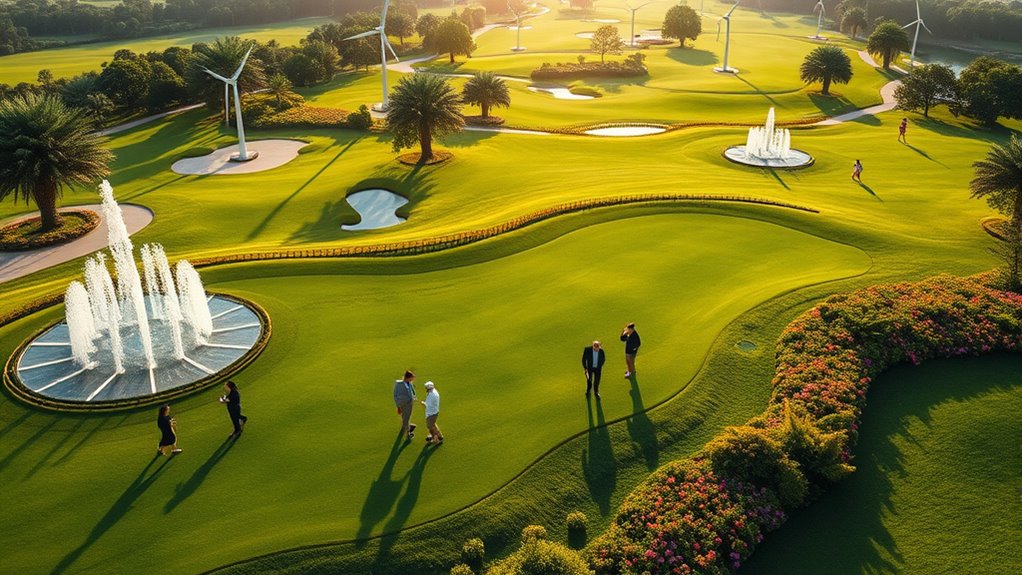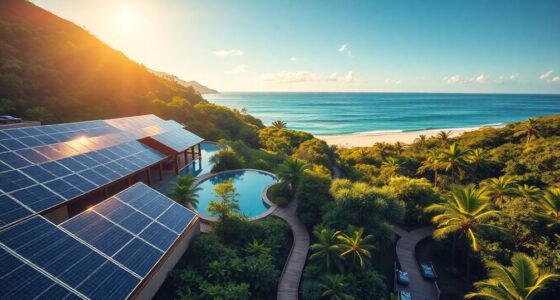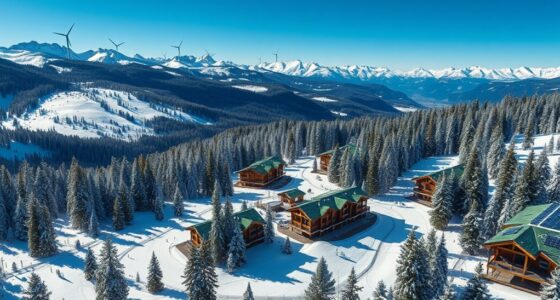Green golf courses are redefining luxury by combining eco-friendly design with innovative technology. You’ll find natural features, native plants, and sustainable materials that reduce environmental impact while enhancing your experience. Water conservation measures like rain harvesting and drought-tolerant landscaping help save resources without sacrificing quality. Plus, eco-tech such as solar lighting and wind turbines creates a seamless, sustainable environment. Stay with us to discover how these green innovations are transforming the way you play and enjoy golf.
Key Takeaways
- Incorporation of native landscaping and biodiversity enhances the natural luxury experience while supporting local ecosystems.
- Use of eco-friendly materials and sustainable construction practices demonstrates a commitment to environmentally responsible luxury.
- Integration of renewable energy technologies like solar pathways and wind turbines creates seamless, eco-conscious amenities.
- Thoughtful placement of recreational amenities with natural features promotes a luxurious yet sustainable environment.
- Emphasizing water conservation through rainwater harvesting and xeriscaping balances high-end aesthetics with eco-friendly practices.
Incorporating Sustainable Design Elements

To create truly sustainable golf courses, designers must incorporate eco-friendly elements into their plans from the start. You’ll want to integrate natural features and low-impact materials to reduce environmental footprints. Thoughtful placement of recreational amenities, like walking trails and eco-conscious clubhouses, enhances the overall experience without harming the landscape. These green design choices not only boost membership benefits by appealing to environmentally conscious players who value sustainability, but they also support the development of cultural intelligence among staff and members to foster a shared commitment to environmentally responsible practices. Incorporating native vegetation minimizes water and fertilizer needs, while energy-efficient lighting and solar systems further decrease operational impacts. These measures not only protect the environment but also create a more attractive, healthy course for members. Ultimately, sustainable design elevates the club’s reputation, encourages long-term patronage, and sets a standard for responsible golf course development.
Innovative Water Conservation Techniques

Implementing innovative water conservation techniques is essential for maintaining sustainable golf courses, especially in regions facing water scarcity. One effective method is rainwater harvesting, which captures and stores rainfall for irrigation, reducing reliance on municipal water sources. This system guarantees a consistent water supply during dry periods and minimizes runoff. Additionally, xeriscaping techniques help you design landscapes that require minimal water by selecting drought-tolerant plants and reducing turf areas. These practices not only conserve water but also lower maintenance costs and promote eco-friendly grounds. By integrating rainwater harvesting and xeriscaping, you create a resilient, environmentally responsible golf course that balances luxury with sustainability. These techniques demonstrate your commitment to conservation while maintaining stunning, playable fairways. Cookies can be used to enhance user experience and track the effectiveness of these sustainable practices.
Native Landscaping and Biodiversity Promotion

Incorporating native landscaping into your golf course not only enhances its natural beauty but also supports local ecosystems. By using native plantings, you create habitats that attract and sustain native wildlife, promoting biodiversity. These plantings require less water and maintenance, making them an eco-friendly choice. Additionally, designing wildlife corridors allows animals to move safely across different sections of the course, reducing habitat fragmentation. This interconnected landscape helps preserve native species and encourages a thriving ecosystem. Native plants play a crucial role in supporting biodiversity and creating sustainable landscapes. As a result, your course becomes a sanctuary for local flora and fauna while offering players a unique, immersive experience. Native landscaping isn’t just about aesthetics; it’s a strategic step toward sustainable, environmentally conscious golf course management that benefits the entire ecosystem.
Eco-Friendly Materials and Construction Practices

Using eco-friendly materials and construction practices is essential for creating sustainable golf courses. You can incorporate solar lighting along pathways and around key areas, reducing energy consumption and lowering carbon footprints. Recycled bunkers made from reclaimed materials help minimize waste and avoid the environmental impact of new resource extraction. When building greens and fairways, choose sustainable soil and grass varieties that require less water and chemical treatments. Using eco-conscious construction methods, such as minimal land disturbance and erosion control, preserves native ecosystems. These practices not only reduce environmental impact but also demonstrate your commitment to sustainability. Incorporating necessary cookies ensures basic functionalities are maintained during your eco-friendly initiatives. By prioritizing eco-friendly materials and construction techniques, you set a new standard for luxury golf courses that respect and preserve the natural landscape.
Enhancing Player Experience With Green Technology

Advances in green technology are transforming the way players experience the game while also supporting sustainability efforts. You’ll notice how solar pathways light your way at dusk, creating a serene ambiance, and wind turbines silently generate clean energy across the course. These innovations enhance your experience by reducing environmental impact and adding modern touches. Imagine this:
| Visual Elements | Green Tech Features |
|---|---|
| Bright, solar-lit paths | Solar pathways illuminate fairways |
| Gentle breeze turbines | Wind turbines power course lighting |
| Lush, eco-friendly landscape | Sustainable energy sources support operations |
Together, these technologies create a seamless, eco-conscious environment, elevating your game while championing sustainability. With these innovations, playing on a green golf course feels more connected to nature than ever before.
A renewable energy approach ensures the course remains eco-friendly and sustainable for future generations.
Frequently Asked Questions
How Do Green Golf Courses Impact Local Wildlife Populations?
You might wonder how green golf courses affect wildlife populations. They can provide important wildlife habitats, supporting biodiversity preservation by offering food, shelter, and nesting sites. However, if not managed carefully, they can also disrupt local ecosystems through pesticide use or habitat fragmentation. By adopting eco-friendly practices, you help guarantee golf courses positively impact local wildlife, balancing recreation with the preservation of biodiversity and maintaining healthy ecosystems around the course.
What Are the Cost Differences Between Traditional and Eco-Friendly Course Construction?
You might find that eco-friendly course construction costs about 10-20% more than traditional methods. This cost comparison includes sustainable materials and innovative design techniques that reduce long-term expenses. While construction expenses for eco-friendly courses can be higher upfront, they often save money over time through lower water, chemical, and maintenance needs. So, investing a bit more initially can lead to significant savings and environmental benefits down the line.
How Do Green Courses Attract Environmentally Conscious Golfers?
You’re drawn to courses that prioritize sustainability, right? Green courses attract environmentally conscious golfers by showcasing sustainable turf and eco-friendly landscaping that minimize environmental impact. These courses often highlight their commitment to conservation, water efficiency, and native plant use, which resonates with your values. By promoting eco-friendly practices, they create a guilt-free, enjoyable experience, making you feel good about playing while supporting sustainable initiatives in the sport.
What Certifications Verify a Golf Course’s Sustainability Efforts?
Did you know that over 20% of golf courses worldwide now hold a sustainable certification? To verify a course’s eco-friendly efforts, look for certifications like the Audubon Cooperative Sanctuary Program or GEO Certified. These eco label standards guarantee the course meets strict sustainability criteria, from water conservation to habitat preservation. When you choose a certified course, you’re supporting environmentally responsible practices and enjoying your game guilt-free.
How Do Green Courses Handle Maintenance Challenges Without Compromising Ecology?
You handle maintenance challenges by prioritizing water conservation, using efficient irrigation systems, and selecting native grasses that thrive with less water and fewer chemicals. This approach reduces environmental impact while keeping the course healthy and beautiful. By focusing on native plants, you minimize the need for fertilizers and pesticides, ensuring ecological balance. This sustainable strategy guarantees your golf course maintains its aesthetic appeal without compromising the surrounding ecosystem.
Conclusion
As you walk across these green courses, you’re surrounded by lush native plants and shimmering water features that thrive with less waste. The air feels fresher, and the vibrant wildlife flutters nearby, all thanks to eco-friendly practices. Every swing you take blends luxury with sustainability, creating a harmonious balance between nature and sport. These courses aren’t just beautiful—they’re a promise of a greener, more responsible future for golf.










